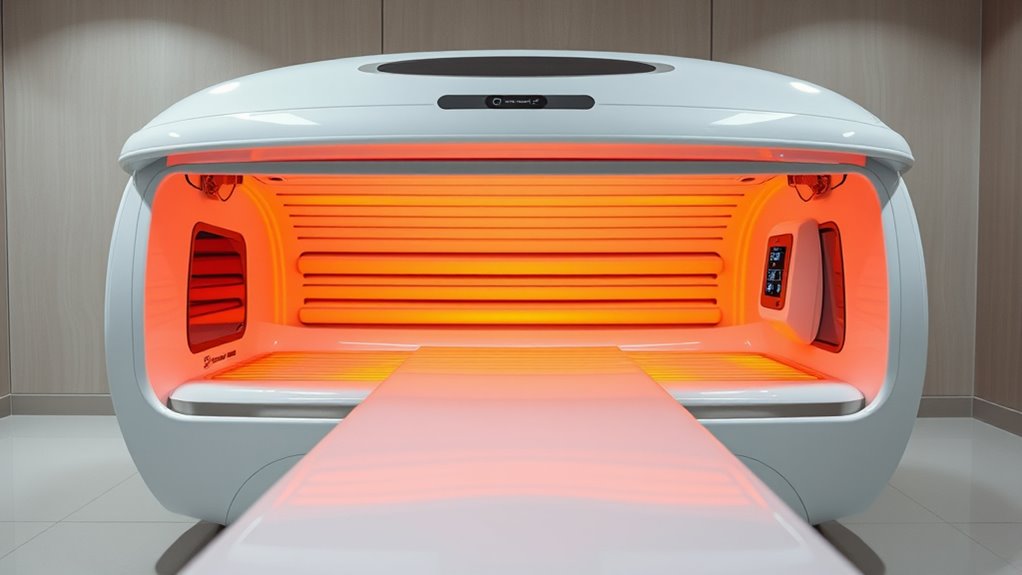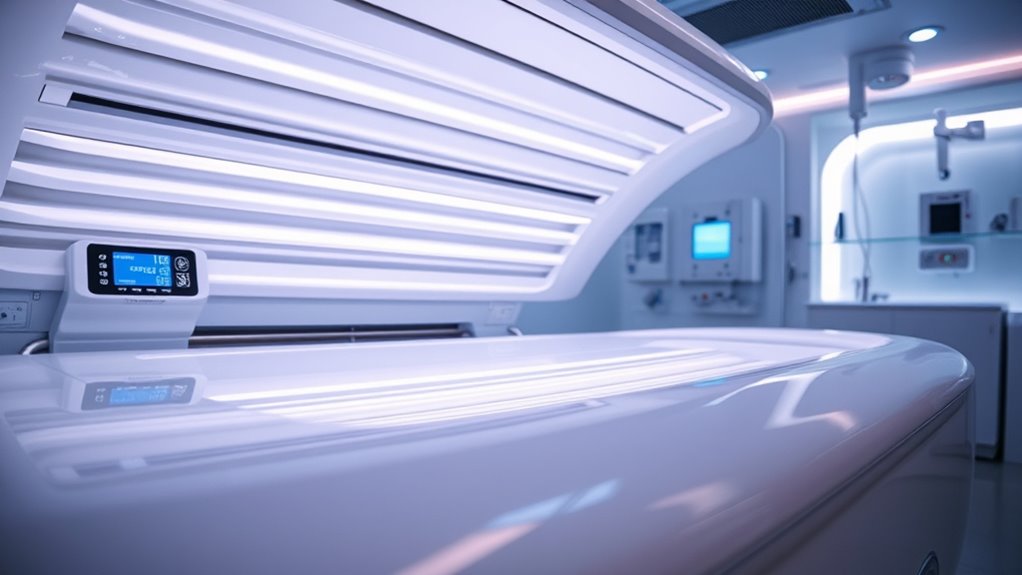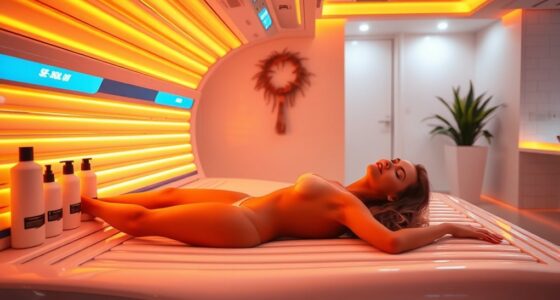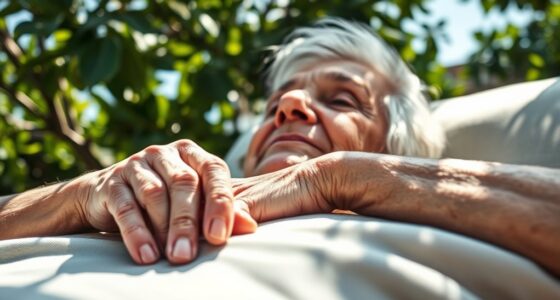Using tanning beds greatly increases your risk of skin damage, premature aging, and skin cancer. They emit intense UV radiation similar to the sun, which harms your skin cells and can cause lasting DNA damage. Studies show no safe level of tanning bed exposure, and they are classified as carcinogenic by the WHO. Avoiding them and exploring safer alternatives helps protect your health now and in the future. Keep going to understand why these risks are so serious.
Key Takeaways
- Research shows tanning beds significantly increase the risk of skin cancer, including melanoma, with no safe UV exposure level.
- Tanning beds emit concentrated UV radiation that damages skin cells and DNA, leading to premature aging and cosmetic issues.
- The WHO classifies tanning beds as carcinogenic to humans, equating their cancer risk to tobacco and asbestos.
- Many misconceptions exist, but evidence confirms tanning beds do not avoid environmental UV factors and are inherently dangerous.
- Safer alternatives like self-tanning products and vitamin D supplements are recommended to achieve desired skin tone without health risks.

Have you ever wondered how safe tanning beds really are? Many people assume that indoor tanning is a quick way to get a sun-kissed glow without the risks of outdoor sun exposure, but the truth isn’t so simple. Tanning beds emit UV radiation, which is the same type of radiation from the sun, and that exposure can be harmful. When you step into a tanning bed, you expose your skin to concentrated UV rays, which can damage your skin cells over time. This damage doesn’t happen overnight, but repeated UV exposure increases your risk of developing skin cancer, including melanoma, basal cell carcinoma, and squamous cell carcinoma. The link between tanning bed use and skin cancer is well-established, with research showing that even occasional use can considerably elevate your risk. It’s essential to understand that UV radiation penetrates deep into your skin, altering DNA and impairing your skin’s ability to repair itself. Over years of exposure, this damage accumulates, making skin cancer a real and present danger for frequent tanners.
The research clearly indicates that no level of UV exposure from tanning beds is completely safe. Many people believe that tanning beds are a safer alternative to outdoor sunbathing because they avoid exposure to environmental factors like pollution or harmful UVB rays that cause sunburn. However, indoor tanning still exposes your skin to intense UV radiation, which is equally, if not more, dangerous. The World Health Organization classifies tanning beds as carcinogenic to humans, putting them alongside tobacco and asbestos. This classification underscores the seriousness of the risk. Even young people, who often think they’re invincible, are vulnerable to the carcinogenic effects of UV radiation from tanning beds. It’s a misconception that tanning beds are a healthy way to boost vitamin D levels—there are safer methods to get vitamin D, such as diet and supplements, without risking skin damage.
In addition to skin cancer, UV exposure from tanning beds can accelerate skin aging, causing wrinkles, age spots, and loss of skin elasticity. These are cosmetic issues, but they’re also signs of underlying damage. If you’re considering tanning beds, it’s imperative to weigh these risks carefully. The bottom line is that the safest choice is to avoid tanning beds altogether. If you want a tan, opt for self-tanning products or sprays that don’t involve UV exposure. Protecting your skin now can save you from serious health issues down the line, and understanding the connection between UV exposure and skin cancer is a crucial step toward making smarter, safer choices.
Frequently Asked Questions
Are There Safe Tanning Alternatives Without Skin Damage?
Yes, there are safe skin alternatives to tanning beds without UV exposure. You can opt for self-tanning lotions or sprays that give you a natural glow without damaging your skin. These options allow you to enjoy a tan without risking skin damage from UV exposure. Always choose products with good reviews and follow the application instructions for the best, safest results.
How Often Can I Use a Tanning Bed Safely?
You should avoid using tanning beds more than once a month to minimize risks. Each session increases your UV exposure, which can cause significant skin damage—like speeding up aging or raising your skin cancer risk. Even infrequent use isn’t without danger, so it’s better to seek safer alternatives. Prioritize protecting your skin and limit your UV exposure to keep your skin healthy and youthful.
Do Tanning Salons Follow Proper Safety Regulations?
Most tanning salons follow regulation enforcement and prioritize safety compliance, but it’s not guaranteed everywhere. You should always check if the salon adheres to local laws and safety standards before using their services. Look for certified staff, proper equipment maintenance, and clear safety instructions. If a salon neglects regulation enforcement or safety compliance, it’s best to find a more reputable place to protect your health.
Can Tanning Beds Cause Long-Term Skin Health Issues?
You might think a quick tan won’t harm, but UV exposure from tanning beds is like a slow burn on your skin’s future. It can cause long-term skin health issues, accelerating skin aging and increasing cancer risks. Over time, your skin loses its youthful elasticity, turning into a map of fine lines and age spots. Protect yourself now—your skin’s future self will thank you for avoiding this silent threat.
Are There Age Restrictions for Tanning Bed Use?
Yes, there are age restrictions for tanning bed use. Youth access laws vary by location, but many places prohibit minors from using tanning beds to protect young skin. You should check your local regulations, as age regulations are in place to reduce health risks. If you’re considering tanning, make sure you’re aware of these restrictions to avoid legal issues and minimize long-term skin health problems.
Conclusion
When it comes to tanning beds, the research paints a clear picture: they’re more than just a harmless way to get a glow. The risks, especially skin cancer, are massive, overshadowing any temporary tan. Don’t let the allure of instant beauty blind you—this is one of the biggest health threats you face. Stay safe, skip the beds, and protect your skin like your life depends on it—because, honestly, it does.









